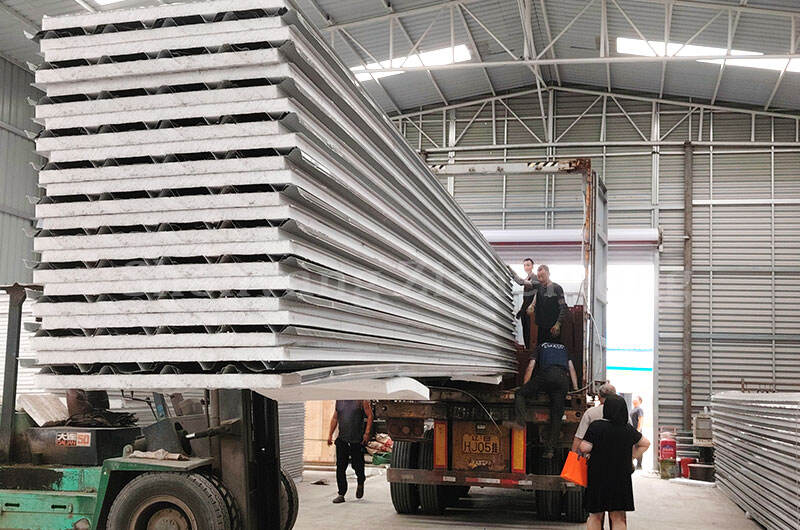Why Steel Structures Are Vulnerable to Fire
The Critical Temperature Threshold for Structural Steel Degradation
Steel structures start losing their strength pretty quickly when exposed to heat. At around 550 degrees Celsius (that's about 1022 Fahrenheit), steel can only support half of what it normally would. Complete collapse usually happens somewhere between 600 and 700 degrees Celsius as per those ASTM fire standards we all know about. The reason for this weakness lies in how conductive steel is to heat. With a thermal conductivity rating of about 45 to 50 watts per meter Kelvin, heat moves through steel beams and columns really fast compared to other materials. Concrete and brick have built-in fire resistance that steel just doesn't possess naturally. Without protection, steel components can hit dangerous temperatures within 18 minutes in typical fire scenarios tested under UL 263 standards. This means whole buildings could become unstable much faster than people realize during fires.
Consequences of Fire-Induced Collapse in Commercial and Industrial Buildings
When just one steel beam gets damaged, it can set off a chain reaction that brings down entire sections of big open buildings like those massive warehouses over 10,000 square feet. Take what happened at a logistics center back in 2022 where the temperature inside soared past 800 degrees Celsius within barely half an hour before parts of the building started giving way. According to the National Fire Protection Association's latest data from 2023, these kinds of industrial fires typically cost around $2.4 million each time they happen, though this doesn't account for all the money lost when operations have to shut down. The problem gets worse in factories with their wide open floor plans since flames tend to spread three times faster there compared to places that are divided into smaller sections, making structural collapses far more likely during emergencies.
This inherent vulnerability explains why 78% of architects now prioritize integrating fire-resistant materials like sandwich panels during the planning phase of steel structure projects.
How Sandwich Panels Provide Passive Fire Protection
Thermal insulation properties of sandwich panels during fire exposure
Sandwich panels serve as effective thermal barriers that really slow down how heat moves toward structural steel components. The insulating material inside these panels, usually something like mineral wool or rock wool, can cut temperature increases by around 70% when compared to steel left exposed. This keeps surfaces from getting too hot, staying under 400 degrees Fahrenheit (about 204 Celsius) for quite some time during fires. A recent report from Fire Safety Materials in 2024 suggests that using non-burning core materials helps prevent flames from spreading in roughly 8 out of 10 industrial fire situations. While exact percentages might vary depending on specific conditions, the general trend shows clear benefits for safety.
Extending structural integrity: fire resistance duration beyond 60 minutes
High-performance sandwich panel systems maintain load-bearing capacity for 90–120 minutes in standard fire tests, exceeding minimum building code requirements. This extended protection window allows safer evacuations and gives emergency responders critical time to contain fires before structural collapse begins.
Mechanisms of heat transfer suppression in sandwich panel systems
Three synergistic mechanisms prevent heat from reaching steel frameworks:
- Conduction blocking: Low-thermal-conductivity cores resist heat flow
- Convection interruption: Sealed air pockets within the core disrupt heat circulation
- Radiation reflection: Aluminum or steel facings reflect 85–92% of infrared radiation
Together, these features limit steel temperature increases to 38°F/min (21°C/min), keeping structures below the critical 1,100°F (593°C) deformation threshold.
The Superior Fire Performance of Rock Wool Core Sandwich Panels
Why non-combustible rock wool outperforms EPS, PU, and other core materials
Rock wool sandwich panels stand out when it comes to fire resistance because they're made from minerals rather than synthetic materials. These panels can handle temperatures well beyond 1000 degrees Celsius without melting down or giving off harmful gases, which makes them much better than flammable options such as expanded polystyrene (EPS) and polyurethane (PU). The problem with PU cores becomes apparent pretty quickly during fires since they start losing their structural strength after just about 15 minutes of exposure. Rock wool on the other hand keeps its shape and stability for around two hours even in intense heat conditions. What really sets rock wool apart is how its fibers are arranged, creating what amounts to a natural defense against heat movement. Tests show this arrangement works roughly 43 percent better at stopping heat spread compared to regular foam insulation products. This creates an effective shield that protects steel structures from extreme temperatures.
Compliance with fire safety standards: ASTM E814 and BS 476 for rock wool cores
Certified rock wool sandwich panels meet rigorous international testing protocols:
| Standard | Test Parameter | Rock Wool Performance |
|---|---|---|
| ASTM E814 | Flame spread index | ≤25 (Class A requirement) |
| BS 476 Part 6 | Fire propagation | ≤12 index points |
| BS 476 Part 7 | Surface spread of flame | Class 1 rating |
These performance benchmarks explain why 78% of industrial architects specify rock wool cores in high-risk environments, as confirmed by 2023 construction material surveys.
Case study: Rock wool sandwich panels in a warehouse fire – preserving structural integrity
During a fire at a 12,000m² logistics center, flames engulfed the building for 94 minutes. While adjacent offices with combustible EPS panels collapsed within 23 minutes, the rock wool-clad steel frame:
- Maintained compartmentalization in 87% of fire zones
- Limited steel column temperatures to 482°C (below the 550°C critical threshold)
- Preserved 100% of structural integrity post-fire
Understanding the 'rock wool, class A' certification and its significance
The Class A fire rating signifies non-combustibility under EN 13501-1 standards, requiring:
- No flame spread beyond the ignition point
- Heat release below 2 MJ/m²
- Smoke production under 10% opacity
Achieving this certification makes rock wool sandwich panels mandatory in 34 countries for buildings exceeding 18 meters in height, ensuring alignment with evolving global fire safety regulations.
Achieving Class A Fire Rating in Commercial Building Design
What Defines a Class A Fire Rating and Why It Matters for Building Compliance
Class A fire ratings are basically the gold standard when it comes to how well materials resist spreading flames. These ratings go to stuff that scores between 0 and 25 on the Flame Spread Index according to those ASTM E84 tests everyone talks about. The importance of getting this certification really hits home in places where lots of people gather and evacuation isn't easy, think hospitals, schools, apartment buildings. When buildings actually use these Class A rated sandwich panels, they can hold their structure together for around an hour to two hours during a fire. That kind of holding power makes all the difference for safety, and helps meet those requirements in section 703 of the International Building Code that building inspectors always check for compliance.
| Fire Rating Class | Flame Spread Index (FSI) | Approved Applications |
|---|---|---|
| Class A | 0–25 | Hospitals, schools, high-rises |
| Class B | 26–75 | Offices, retail centers |
| Class C | 76–200 | Warehouses, storage facilities |
Comparative Analysis: Class A vs. Class B/C Sandwich Panels in Real-World Fires
Looking at a warehouse fire incident from 2023 shows how different materials perform under extreme heat. The rock wool core panels classified as Class A kept those steel beams below the dangerous 550 degree Celsius mark for nearly two hours straight. Meanwhile, the polyurethane core panels rated Class C couldn't hold up for much longer than twenty three minutes before giving way completely. This massive difference in protection time makes sense when we check the FSI ratings. Materials in the top tier (Class A) actually cut down on heat moving through them by around seventy one percent compared to what we see with lower quality options like Class C. Makes a big difference when trying to protect valuable assets during emergencies.
Balancing Cost and Safety: Avoiding Compromises in Core Material Quality
Class A rock wool sandwich panels do come with a higher price tag compared to polystyrene options, usually around 15 to 20 percent extra upfront. But what many building owners don't realize is that these panels actually cut down on insurance costs over time. In regions prone to fires or other risks, property owners can expect savings of about $9 to $12 per square foot annually on their insurance premiums. Most top quality manufacturers focus on getting the mineral wool core right, aiming for densities between 92 and 95 percent. This meets those tough ASTM E119 standards for fire resistance all on its own, so there's no need for extra coatings or treatments. And while the initial investment might seem steep, the combination of enhanced safety features and reduced maintenance needs makes these panels a smart choice for facilities looking at long term value and protection against unexpected losses.
FAQ
Why is steel vulnerable to fire?
Steel has high thermal conductivity which allows heat to pass through quickly, causing the material to lose strength when temperatures rise beyond 550 degrees Celsius.
What are sandwich panels and how do they protect steel structures?
Sandwich panels are multi-layered materials that provide thermal insulation and slow down heat transfer. They keep steel temperatures below dangerous levels during fires.
Why are rock wool cores preferred in sandwich panels?
Rock wool is non-combustible and maintains its structural integrity even at high temperatures. It outperforms other core materials like EPS and PU in fire resistance.
What is a Class A fire rating?
Class A rating is the highest fire resistance classification, indicating materials have a Flame Spread Index of 0-25 according to ASTM E84 standards.
Table of Contents
- Why Steel Structures Are Vulnerable to Fire
- How Sandwich Panels Provide Passive Fire Protection
-
The Superior Fire Performance of Rock Wool Core Sandwich Panels
- Why non-combustible rock wool outperforms EPS, PU, and other core materials
- Compliance with fire safety standards: ASTM E814 and BS 476 for rock wool cores
- Case study: Rock wool sandwich panels in a warehouse fire – preserving structural integrity
- Understanding the 'rock wool, class A' certification and its significance
- Achieving Class A Fire Rating in Commercial Building Design
- FAQ

